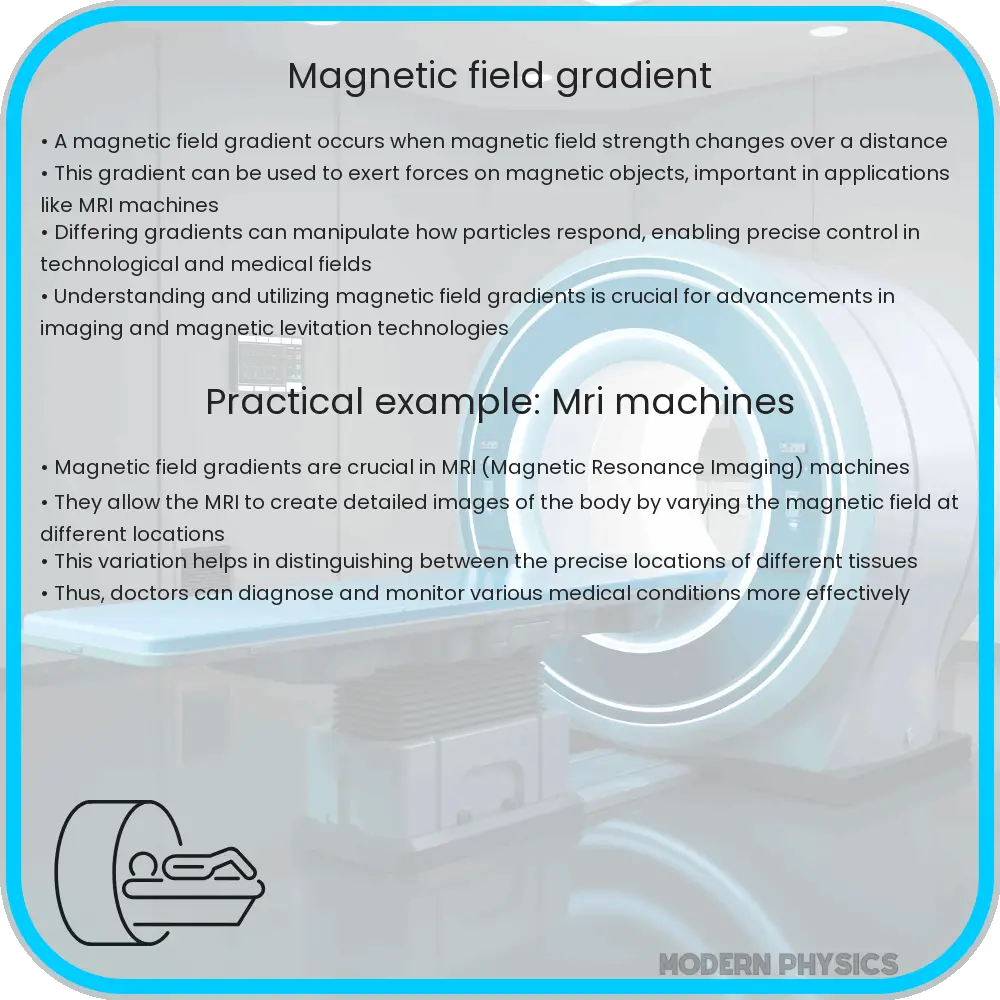Explore the principles, uses, and measurement techniques of magnetic field gradients in MRI, geophysics, and advanced technologies.

Magnetic Field Gradient: An Overview
Magnetic field gradients are essential concepts in the realms of physics and engineering, playing a pivotal role in various applications ranging from medical imaging to geophysics. A magnetic field gradient refers to the spatial variation in the magnetic field intensity, denoted by the change in the magnetic field (B) over a distance. Mathematically, it’s expressed as ∇B, where ∇ denotes the gradient operator.
Principles of Magnetic Field Gradient
The principle underlying the magnetic field gradient is based on Maxwell’s equations, which describe the behavior of electric and magnetic fields. In essence, a gradient occurs when the strength of a magnetic field changes over a spatial dimension. This variation can be linear or more complex, depending on the source of the field and the environment. The unit of measurement for magnetic field gradient is Tesla per meter (T/m).
Uses of Magnetic Field Gradient
- Magnetic Resonance Imaging (MRI): One of the most notable applications of magnetic field gradients is in MRI. Here, gradients are used to encode spatial information into the signals obtained from the body, allowing for the construction of detailed internal images.
- Geophysics and Prospecting: In geophysical exploration, magnetic field gradients help in mapping the distribution of magnetic minerals in the Earth’s crust, aiding in the search for natural resources like oil and minerals.
- Particle Accelerators: Gradients are also crucial in particle accelerators where they are used to focus and steer charged particles along a desired path.
Measurement of Magnetic Field Gradient
Measuring the magnetic field gradient is a critical aspect of utilizing it effectively. Various techniques are employed for this purpose:
- Gradiometers: These instruments measure the difference in magnetic field intensity over a distance. They come in different forms, such as fluxgate, SQUID (Superconducting Quantum Interference Device), and optically pumped magnetometers.
- NMR Techniques: Nuclear Magnetic Resonance (NMR) can also be used to measure magnetic field gradients. By observing the frequency shift of NMR signals, it’s possible to deduce the gradient information.
Understanding and measuring magnetic field gradients is vital for the advancement of technologies in various fields. The continued research and development in this area hold promise for even more innovative applications in the future.
Advanced Applications of Magnetic Field Gradients
As technology progresses, the applications of magnetic field gradients extend into more advanced fields. For instance, in the area of nanotechnology, magnetic field gradients are used to manipulate nanoparticles and nanoscale materials. This manipulation is crucial for fabricating devices at the molecular level. In quantum computing, precise control of magnetic field gradients allows for the manipulation of qubits, which are the fundamental units of quantum information.
Challenges and Future Prospects
Despite their widespread use, working with magnetic field gradients presents unique challenges. One major issue is the need for extremely uniform and stable magnetic fields, especially in applications like MRI, where even minor fluctuations can lead to image artifacts. Additionally, designing sensors that can accurately measure high gradients is a field of ongoing research.
Looking ahead, the future of magnetic field gradients seems to be intertwined with the advancement of superconducting and nanomaterial technologies. These advancements could lead to more precise and powerful gradient systems, expanding the scope of their applications even further. For example, in medical diagnostics, higher gradient strengths could result in faster and more detailed imaging capabilities.
Conclusion
Magnetic field gradients play a crucial role in modern technology and scientific research. From medical imaging in MRI scanners to the exploration of Earth’s subsurface in geophysics, their applications are diverse and impactful. The measurement of these gradients, though challenging, has evolved with the advent of sophisticated instruments like gradiometers and NMR techniques. As technology continues to advance, particularly in fields like nanotechnology and quantum computing, the importance and applications of magnetic field gradients are expected to grow exponentially. This underscores the need for continued research and development in this area, promising exciting breakthroughs and innovations in the years to come.
